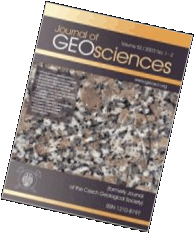 Export to Mendeley
Export to MendeleyOriginal paper
Alfredcasparite, Sr2TiO(Si2O7), a new mineral from the Caspar quarry, Bellerberg volcano, Germany, and new data on wesselsite, SrCuSi4O10
Journal of Geosciences, volume 69 (2024), issue 3, 161 - 172
DOI: http://doi.org/10.3190/jgeosci.394
The new mineral alfredcasparite, ideally Sr2TiO(Si2O7), is a Sr-analogue of fresnoite Ba2TiO(Si2O7). It is an accessory phase, which was found in a silicate xenolith within the tephritic lava from the Caspar quarry, Bellerberg volcano, Germany. Usually, alfredcasparite occurs together with potentially new mineral (Sr2Na)Ti(Si2Fe)Si2O14, in small cracks in the K-feldspar (sanidine)-quartz-pyroxene (aegirine-diopside)-matrix, and wollastonite. In the type material, alfredcasparite rarely forms flattened crystals up to 30 μm in diameter; more common are irregular grains which do not exceed 15 μm in size. Alfredcasparite is colourless, transparent, and has a vitreous lustre and white streak. It is brittle with an irregular fracture and exhibits good cleavage on (001). The calculated density equals 3.950 g‧cm-3 and the Mohs hardness is ~3-4. Optically, alfredcasparite is uniaxial and non-pleochroic under transmitted light (nmean = 1.823). The empirical formula calculated based on 8 O atom per formula unit (pfu) is (Sr1.54Ba0.29Ca0.10Na0.03K0.03)∑1.99(Ti0.94Fe0.04Mg0.03)∑1.01(Si2.04Al0.01)∑2.05O8, which leads to the ideal end-member formula Sr2TiO(Si2O7). According to the electron back-scattered diffraction (EBSD) pattern, tetragonal alfredcasparite fit to the using structural model of synthetic Sr2TiO(Si2O7) with the following parameters: space group P4bm, a = 8.32 Å, c = 5.02 Å, V = 347.77 Å3, Z = 2. The crystal structure consists of layers composed of corner-sharing TiO5 square-base pyramids and Si2O7 disilicate units, with interstices occupied by Sr2+ cations. The Raman spectrum of alfredcasparite is characterised by a sharp and intense Raman band at 863 cm-1 with lower-intensity shoulder bands at ∼850 and 874 cm-1, which have a complex nature and are assigned to both symmetric stretching SiO3 vibrations of the disilicate group (Si2O7)6- and Ti-O vibrations in the square pyramid (TiO5)6-. The authors assume that alfredcasparite forms as an effect of residual melt crystallisation enriched in incompatible elements like Ba, Sr, Ti, or P at a temperature around 1000 ˚C. In addition, based on chemical EPMA and Raman spectroscopy investigations, the second world occurrence of wesselsite, SrCuSi4O10, was confirmed in the same xenolith. Chemical analyses resulted in the empirical formula (based on 10 O pfu) (Sr0.67Ba0.28Ca0.04Na0.01K0.01)∑1.01 (Cu0.93Mg0.04Fe0.02)∑0.99Si4.01O10. Furthermore, the Raman spectrum of natural wesselsite was obtained and described in detail for the first time, in relation to its crystal structure.
Webdesign inspired by aTeo. Hosted at the server of the Institute of Petrology and Structural Geology, Charles University, Prague.
ISSN: 1803-1943 (online), 1802-6222 (print)
email: jgeosci(at)jgeosci.org


IF (WoS, 2024): 1.3
5 YEAR IF (WoS, 2024): 1.4
Policy: Open Access
ISSN: 1802-6222
E-ISSN: 1803-1943